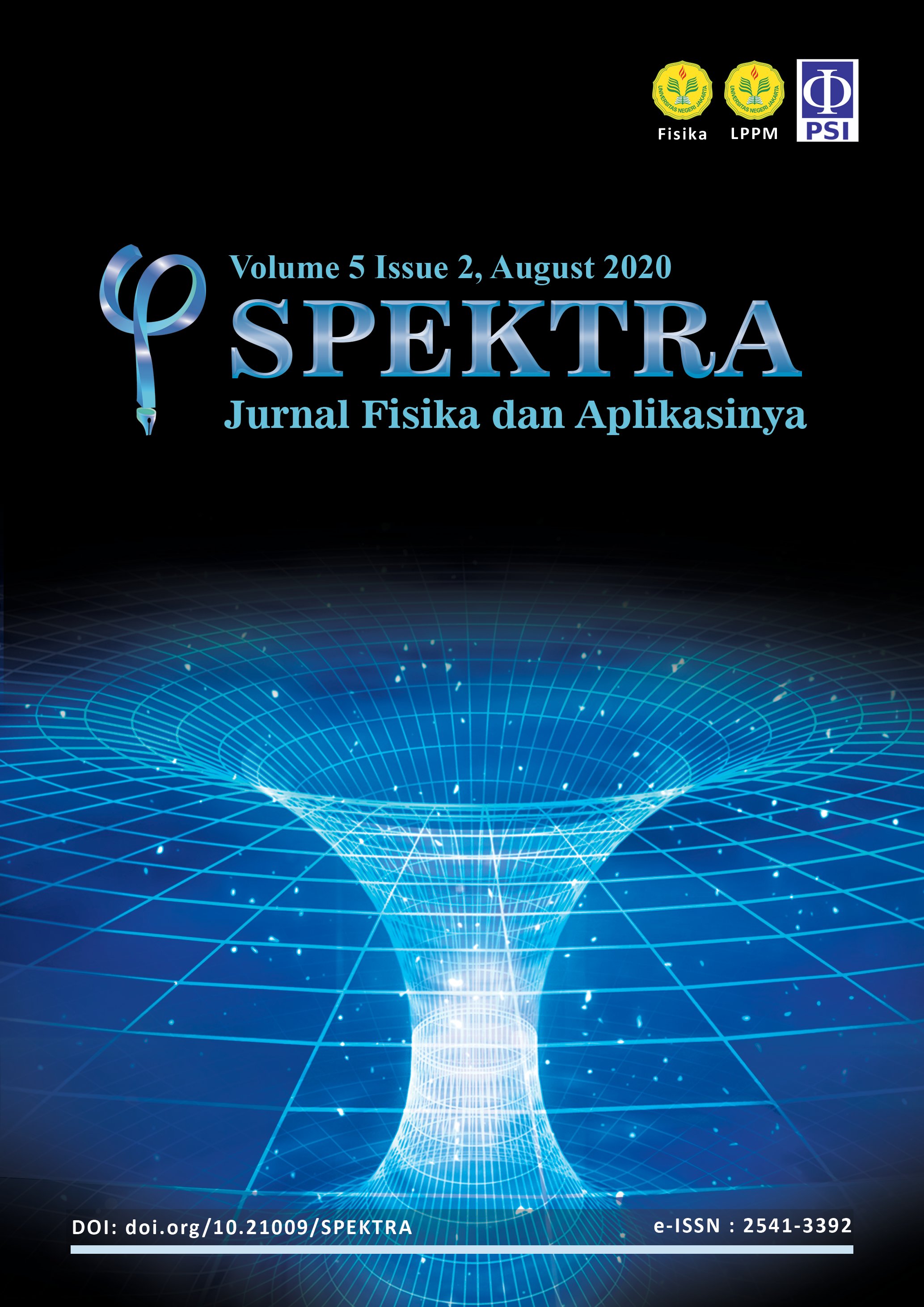THE SYNTHESIS AND CHARACTERIZATION OF ZINC OXIDE THIN FILM DOPING SELENIUM
DOI:
https://doi.org/10.21009/SPEKTRA.052.08Keywords:
selenium doped ZnO nanorods, seed-mediated hydrothermal method, UV-Vis, XRD, FESEMAbstract
The selenium-doped ZnO nanomaterial has successfully grown the surface of FTO (Fluorine Tin Oxide) using a seed-mediated hydrothermal method at a temperature of 90°C for 5 hours. In this research, the doping selenium by variation the volume of selenium solution at 0 mL, 0.025 mL dan 0.2 mL. This is an impact on the optical properties and morphology of ZnO nanorods. The samples were characterized using UV-Vis spectroscopy, X-Ray Diffraction and Field Emission Scanning Electron Microscopy (FESEM). The UV-Vis spectra showed that strong absorption occurs in the wavelength range of 300-380 nm. The 0.025 mL Se doped ZnO was the highest absorption compared to other samples. The XRD pattern exhibited five peaks at an angle of 2θ: 31.70°; 34.4°; 36.2°; and 47.5°. representing the orientation of the crystal planes (100), (002), (101), and (102) of hexagonal lattice. The FESEM images showed that Se doped ZnO with hexagonal face shape. The 0.2 mL Se doped ZnO was the most uniform compared to other samples.
References
[2] G. C. Park et al., “Growth Behavior and electrical performance of Ga-Doped ZnO nanorod/p-si heterojunction diodes prepared using a hydrothermal method,” Nanoscale, 2014.
[3] C. Bauer et al., “Electron Injection and Recombination in Ru(dcbpy)2(NCS)2 Sensitized Nanostructured ZnO,” The Jurnal Of Physical Chemistry, 2001.
[4] R. Thangavel and Y. C. Chang, “Investigation on structural, optical and electrical properties of p-type ZnO nanorod using hydrothermal method,” Thin Solid Films, 2012.
[5] Iwantono et al., “Effect of growth temperature and time on the ZnO film properties and the performance of dye sensitized solar cell (DSSC),” J. Solid State Electrochem, 2015.
[6] X. Xu et al., “Arrays of CdSe sensitized ZnO/ZnSe nanocables for efficient solar cells with high open-circuit voltage,” J. Mater. Chem., 2012, vol. 22.
[7] Y. Wang, M. Zhong and W. Wang, “Effects of Se-ZnO Modification on the Perovskit Films and Perovskit Solar Cells Based on ZnO Nanorod Arrays,” Applied Surface Science, 2019.
[8] A. T. Surono dan H. Sutanto, “Sifat Optik Zinc Oxida (ZnO) yang di deposisi di Atas Substrat Kaca Menggunakan Metode Chemical Solution Deposition (CSD) dan Aplikasinya untuk Degradasi Zat Warna Methylene Blue,” Youngster Physic Journal, 2014.
[9] C. Liu, W. Jie, “Synthesis methods and process research of Se-ZnO polycrystalline,” Mater, 2007.
[10] W. Zhang et al., “ Enhancement Of Ultraviolet Emissions From Zno Film By Ag Doping,” Appl. Phys. Lett., 2006.
[11] K. Wang et al., “Direct Growth of Highly Mismatched Type II ZnO/ZnSeCore/Shell Nanowire Arrays on Transparent Conducting Oxide Substrates for Solar Cell Applications,” A. Materials, 2008.
Downloads
Published
How to Cite
Issue
Section
License
SPEKTRA: Jurnal Fisika dan Aplikasinya allow the author(s) to hold the copyright without restrictions and allow the author(s) to retain publishing rights without restrictions. SPEKTRA: Jurnal Fisika dan Aplikasinya CC-BY or an equivalent license as the optimal license for the publication, distribution, use, and reuse of scholarly work. In developing strategy and setting priorities, SPEKTRA: Jurnal Fisika dan Aplikasinya recognize that free access is better than priced access, libre access is better than free access, and libre under CC-BY or the equivalent is better than libre under more restrictive open licenses. We should achieve what we can when we can. We should not delay achieving free in order to achieve libre, and we should not stop with free when we can achieve libre.
 SPEKTRA: Jurnal Fisika dan Aplikasinya is licensed under a Creative Commons Attribution 4.0 International License.
SPEKTRA: Jurnal Fisika dan Aplikasinya is licensed under a Creative Commons Attribution 4.0 International License.
You are free to:
Share - copy and redistribute the material in any medium or format
Adapt - remix, transform, and build upon the material for any purpose, even commercially.
The licensor cannot revoke these freedoms as long as you follow the license terms.

 E-ISSN 2541-3392
E-ISSN 2541-3392  Focus & Scope
Focus & Scope  Editorial Team
Editorial Team  Reviewer Team
Reviewer Team  Author Guidelines
Author Guidelines  Article Template
Article Template  Author Fee
Author Fee  Publication Ethics
Publication Ethics  Plagiarism Policy
Plagiarism Policy  Open Access Policy
Open Access Policy  Peer Review Process
Peer Review Process  Retraction & Correction
Retraction & Correction  Licensing & Copyright
Licensing & Copyright  Archiving & Repository
Archiving & Repository  Contact
Contact  Mendeley
Mendeley 

